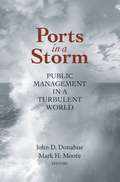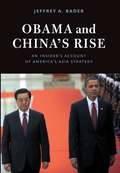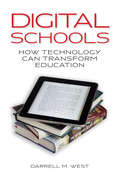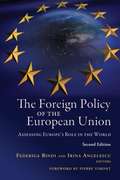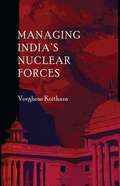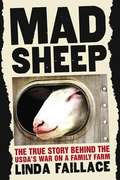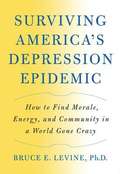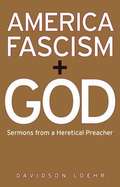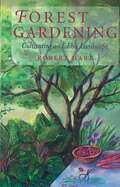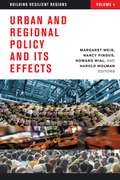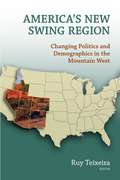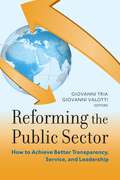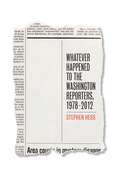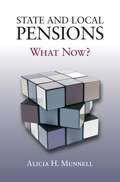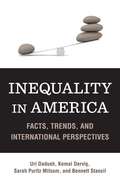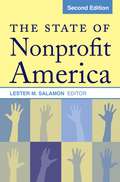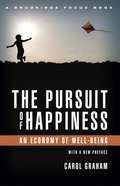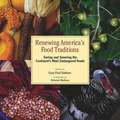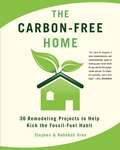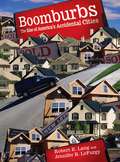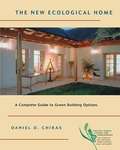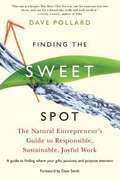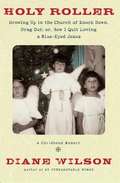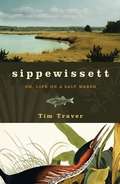- Table View
- List View
Ports in a Storm
by John D. Donahue Mark H. MooreIn Ports in a Storm a team of Harvard Kennedy School scholars focus diverse conceptual lenses on a single high-stakes management task--enhancing port security across the United States. Their aims are two: to understand how a public manager might confront that complex undertaking, and to explore the similarities, differences, and complementarities of their alternative approaches to public management.The book takes as its pivot point the singular case of U.S. Coast Guard Captain Suzanne Englebert and her leadership of efforts to secure America's ports after the September 11 attacks. The Coast Guard had always been responsible for securing America's ports and coastline. But now it was tasked with safeguarding these critical, complex, and vulnerable assets during a time of war, a job it clearly could not handle alone. Ports in a Storm considers the monumental challenge of driving rapid change in a complex system involving hundreds of private organizations and scores of government agencies with their operations intricately intertwined. The book examines Englebert's actions from varied conceptual vantage points, sometimes critiquing questionable calls but more often celebrating her initiative, creativity, persistence, and skill.The authors use the Coast Guard episode as a testing ground for the eclectic intellectual constructs they have been developing to guide public managers. Instead of starting with theory and searching for examples that fit, they begin with the concrete and then harness scholarship to the service of better practice. And rather than mimic management principles from the business world, they tailor their approach to the very different challenges of managing in a public sector context. The volume allows readers in both the scholarly and practical worlds to see how the theories measure up.Contributors, including the two volume editors, are Robert D. Behn, John D. Donahue, Archon Fung, Stephen Goldsmith, Elaine Kamarck, Herman B. Leonard, Mark H. Moore, Malcolm K. Sparrow, Pamela Varley, and Richard Zeckhauser.
Obama and China's Rise
by Jeffrey A. Bader"Future presidents will need to find the right balance in China policy, so as to maintain America's strength and watchfulness but not fall into the classic security dilemma, wherein each side believes that growing capabilities reflect hostile intent and responds by producing that reality. I believe that President Obama struck that balance." --From Obama and China's RiseIn 2005, veteran diplomat and Asia analyst Jeffrey Bader met for the first time with the then-junior U.S. senator from Illinois. When Barack Obama entered the White House a few years later, Bader was named the senior director for East Asian affairs on the National Security Council, becoming one of a handful of advisers responsible for formulating and implementing the administration's policy regarding that key region. For obvious reasons--a booming economy, expanding military power, and increasing influence over the region--the looming impact of a rising China dominated their efforts.Obama's original intent was to extend U.S. influence and presence in East Asia, which he felt had been neglected by a Bush administration fixated on the Middle East, particularly Iraq, and the war on terror. China's rise, particularly its military buildup, was heightening anxiety among its neighbors, including key U.S. allies Japan and South Korea. Bader explains the administration's efforts to develop stable relations with China while improving relationships with key partners worried about Beijing's new assertiveness.In Obama and China's Rise, Bader reveals what he did, discusses what he saw, and interprets what it meant--first during the Obama campaign, and then for the administration. The result is an illuminating backstage view of the formulation and execution of American foreign policy as well as a candid assessment of both. Bader combines insightful and authoritative foreign policy analysis with a revealing and humanizing narrative of his own personal journey.
Digital Schools
by Darrell M. WestNearly a century ago, famed educator John Dewey said that "if we teach today's students as we taught yesterday's, we rob them of tomorrow." That wisdom resonates more strongly than ever today, and that maxim underlies this insightful look at the present and future of education in the digital age.As Darrell West makes clear, today's educational institutions must reinvent themselves to engage students successfully and provide them with the skills needed to compete in an increasingly global, technological, and online world. Otherwise the American education system will continue to fall woefully short in its mission to prepare the population to survive and thrive in a rapidly changing world.West examines new models of education made possible by enhanced information technology, new approaches that will make public education in the post-industrial age more relevant, efficient, and ultimately more productive. Innovative pilot programs are popping up all over the nation, experimenting with different forms of organization and delivery systems. Digital Schools surveys this promising new landscape, examining in particular personalized learning; realtime student assessment; ways to enhance teacher evaluation; the untapped potential of distance learning; and the ways in which technology can improve the effectiveness of special education and foreign language instruction. West illustrates the potential contributions of blogs, wikis, social media, and video games and augmented reality in K-12 and higher education.Technology by itself will not remake education. But if today's schools combine increased digitization with needed improvements in organization, operations, and culture, we can overcome current barriers, produce better results, and improve the manner in which schools function. And we can get back to teaching for tomorrow, rather than for yesterday.
The Foreign Policy of the European Union
by Irina Angelescu Federiga BindiIn a relatively short time, the EU has become one of the most important actors on the world stage. This updated second edition of The Foreign Policy of the European Union explores the goals and effectiveness of the EU's external actions after adoption of the Lisbon Treaty. The book brings together prominent scholars and policymakers who provide an up-to-date view of the EU's foreign policy merits and challenges."The role and place of the European Union in the world has been a constant question for all of the actors involved.... This book reminds us well of the importance of this question and offers a particularly welcome general overview during these times of doubt and pessimism."--Pierre Vimont, from the foreword
Managing India's Nuclear Forces
by Verghese KoitharaIndia is now enmeshed in the deterrence game--actively with its traditional adversary Pakistan, and potentially with China. At the same time it is finding easier access to fissile materials and strategic technologies. In order to deal with these developments safely and wisely, the nation needs a much more sophisticated and multidisciplinary understanding of the strategic, technological, operational, and cost issues involved in nuclear matters.In this important book, Indian strategic analyst Verghese Koithara explains and evaluates India's nuclear force management, encouraging a broad public conversation that may act as a catalyst for positive change before the subcontinent experiences unthinkable carnage. The defense management system of a nuclear power absolutely needs to be sound and thorough. In addition to the considerable demands of managing its nuclear forces, it also must control conventional forces in a manner that forestalls nuclear escalation of a conflict by either side. Expanding and upgrading nuclear forces without enhancing deterrence is dangerous and should be avoided. India's nuclear force management system is grafted onto a woefully inadequate overall system of defense management.Koithara dissects all of these issues and suggests a way forward, drawing on recent developments in deterrence theory around the world.
Mad Sheep
by Linda FaillaceIn the mid-1990s Linda and Larry Faillace had a dream: they wanted to breed sheep and make cheese on their Vermont farm. They did the research, worked hard, followed the rules, and, after years of preparation and patience, built a successful, entrepreneurial business. But just like that, their dream turned into a nightmare. The U. S. Department of Agriculture told them that the sheep they imported from Europe (with the USDA's seal of approval) carried a disease similar to the dreaded BSE or "mad cow disease. " After months of surveillance-which included USDA agents spying from nearby mountaintops and comically hiding behind bushes-armed federal agents seized their flock. The animals were destroyed, the Faillace's lives turned upside down, all so that the USDA could show the U. S. meat industries that they were protecting America from mad cow disease-and by extension, easing fears among an increasingly wary population of meat-eaters. "Mad Sheep" is the account of one family's struggle against a bullying and corrupt government agency that long ago abandoned the family farmer to serve the needs of corporate agriculture and the industrialization of our food supply. Similar to the national best-selling book, "A Civil Action," readers will cheer on this courageous family in its fight for justice in the face of politics as usual and the implacable bureaucracy of the farm industry in Washington, DC.
Surviving America's Depression Epidemic
by Bruce E. LevineThe rate of depression in the U. S. has increased more than tenfold in the last fifty years. By not seriously confronting societal sources of despair, American mental health institutions have become part of the problem rather than the solution. The good news is that age-old wisdom and legitimate science--uncorrupted by the profit-margin pressures of pharmaceutical and insurance corporations--have much to inform us about revitalizing depressed people and a depressing culture. "Surviving America's Depression Epidemic" provides an alternate approach that encompasses the whole of our humanity, society, and culture, and which redefines depression in a way that makes enduring transformation more likely.
America Fascism and God
by Davidson LoehrReligion and politics have always been a potent mix. History is littered with times when that combination caused sweeping death and destruction, when it fueled aggression and oppression-and when it gave fascism a religious and diplomatic face. Reverend Davidson Loehr is afraid that we may be living in such a time in America today. On the Sunday following the election on November 2, 2004, Loehr, a liberal minister in Texas, delivered a sermon titled "Living Under Fascism"-a sermon that spread like wildfire through the Internet. "I mean to persuade you that the style of governing into which America has slid is most accurately described as fascism, and that the necessary implications of this fact are rightly regarded as terrifying," the preacher told his congregation. ". . . and even if I don't persuade you, I hope to raise the level of your thinking about who and where we are now. " In this series of incisive and inspired sermons, Loehr takes aim at the unholy alliance of corporate money, political power, and religious fundamentalism that is threatening both our political and our economic democracy. But Loehr's words provide little comfort to liberals and progressives who have stubbornly clung to a radical individualism and an amoral secularism. "America, Fascism, and God" is a call-first to understand that religion has been hijacked and debased. And then to take it back.
Forest Gardening
by Robert Hart"Forest Gardening" is a way of working alongside nature--an approach that results in great productivity with minimal maintenance, and a method for transforming even a small cottage garden into a diverse and inviting habitat for songbirds, butterflies, and other wildlife. Based on the model of a natural woodland, a forest garden incorporates a wide variety of useful plants, including fruit and nut trees, perennial herbs, and vegetables. Hart's book beautifully describes his decades of experience gardening in the Shropshire countryside, yet the principles of "backyard permaculture" he explores can be applied equally well in other locales across the planet, from tropical to temperate zones. Practical features of the book include: bull; Design guidelines for creating your own perennial, food-producing garden bull; Lists of recommended plants and varieties, keyed to different climates bull; An explanation of how plants in different levels or "stories"--from ground covers to full-sized trees--coexist and interact in a healthy and productive landscape. Robert Hart blends history, philosophy, anthropology, and seasonal gardening wisdom in a lucid sequence of essays, which together comprise a remarkable testament to the pleasures of "hands-off" as well as hands-on gardening. "Forest Gardening" is truly a book for our times, offering a fresh sensibility that will encourage and inspire ecological gardeners throughout the world.
Urban and Regional Policy and Its Effects
by Nancy Pindus Margaret Weir Howard Wial Harold WolmanThe mission of the Urban and Regional Policy and Its Effects series is to inform policymakers, practitioners, and scholars about the effectiveness of select policy approaches, reforms, and experiments in addressing the key social and economic problems facing today's cities, suburbs, and metropolitan areas.Volume four of the series introduces and examines thoroughly the concept of regional resilience, explaining how resilience can be promoted--or impeded--by regional characteristics and public policies.The authors illuminate how the walls that now segment metropolitan regions across political jurisdictions and across institutions--and the gaps that separate federal laws from regional realities--have to be bridged in order for regions to cultivate resilience.Contributors: Patricia Atkins, George Washington University; Pamela Blumenthal, U.S. Department of Housing and Urban Development; Sarah Ficenec, George Washington University; Alec Friedhoff, Brookings Institution; Kathryn Foster, University at Buffalo, SUNY; Juliet Gainsborough, Bentley University; Edward Hill, Cleveland State University; Kate Lowe, Cornell University; John Mollenkopf, Graduate Center, City University of New York; Mai Nguyen, University of North Carolina, Chapel Hill; Manuel Pastor, University of Southern California; Rolf Pendall, Urban Institute; Nancy Pindus, Urban Institute; Sarah Reckhow, Michigan State University; Travis St. Clair, George Washington University; Todd Swanstrom, University of Missouri, St. Louis; Margaret Weir, University of California, Berkeley; Howard Wial, Brookings Institution; Harold Wolman, George Washington University
America's New Swing Region
by Ruy A. TeixeiraThe Mountain West--Arizona, Colorado, Idaho, Nevada, New Mexico, and Utah--has become the new swing region in American politics. All signs point to these states, especially Colorado, Nevada and New Mexico, being crucial in the 2012 election. Unfortunately, the rise of this region has been underreported in the media, and many political observers have only the most superficial understanding of the profound economic, political, and social changes that continue to reshape the Mountain West. America's New Swing Region is the remedy.Led by bestselling author and political analyst Ruy Teixeira, a talented group of scholars assembled by the Brookings Mountain West program (housed at the University of Nevada-Las Vegas) presents the facts and the narrative necessary for understanding what is happening in this region and why it is so important.Contents 1. Introduction and Overview2. America's New Swing Region: The Political Demography and Geography of the Mountain West3. Metropolitan Voting Patterns in the Mountain West: The New and Old Political Heartlands4. Hispanics, Race, and the Changing Political Landscape of the United States Mountain West5. The Political Attitudes of the Millennial Generation in the Mountain West6. The Mountain West Today: A Regional Survey7. Reapportionment and Redistricting in the Mountain WestContributors include Karlyn Bowman (American Enterprise Institute), David Damore(University of Nevada-Las Vegas (UNLV), William Frey (Brookings Institution), Scott Keeter (Pew Research Center), Robert E. Lang (Brookings, UNLV, and the Lincy Institute), Tom Sanchez (Virginia Tech University), and Ruy Teixeira (Century Foundation and the Center for American Progress).
Reforming the Public Sector
by Giovanni Valotti Giovanni TriaMany countries are still struggling to adapt to the broad and unexpected effects of modernization initiatives. As changes take shape, governments are challenged to explore new reforms. The public sector is now characterized by profound transformation across the globe, with ramifications that are yet to be interpreted. To convert this transformation into an ongoing state of improvement, policymakers and civil service leaders must learn to implement and evaluate change. This book is an important contribution to that end. Reforming the Public Sector presents comparative perspectives of government reform and innovation, discussing three decades of reform in public sector strategic management across nations. The contributors examine specific reform-related issues including the uses and abuses of public sector transparency, the "Audit Explosion," and the relationship between public service motivation and job satisfaction in Europe.This volume will greatly aid practitioners and policymakers to better understand the principles underpinning ongoing reforms in the public sector. Giovanni Tria, Giovanni Valotti, and their cohorts offer a scientific understanding of the main issues at stake in this arduous process. They place the approach to public administration reform in a broad international context and identify a road map for public management.Contributors include: Michael Barzelay, Nicola Bell?, Andrea Bonomi Savignon, Geert Bouckaert, Luca Brusati, Paola Cantarelli, Denita Cepiku, Francesco Cerase, Luigi Corvo, Maria Cucciniello, Isabell Egger-Peitler, Paolo Fedele, Gerhard Hammerschmid, Mario Ianniello, Elaine Ciulla Kamarck, Irvine Lapsley, Peter Leisink, Mariannunziata Liguori, Renate Meyer, Greta Nasi, James L. Perry, Christopher Pollitt, Adrian Ritz, Raffaella Saporito, MariaFrancesca Sicilia, Ileana Steccolini, Bram Steijn, Wouter Vandenabeele, and Montgomery Van Wart.
Whatever Happened to the Washington Reporters, 1978-2012
by Stephen HessWhatever Happened to the Washington Reporters, 1978-2012, is the first book to comprehensively examine career patterns in American journalism. In 1978 Brookings Senior Fellow Stephen Hess surveyed 450 journalists who were covering national government for U.S. commercial news organizations. His study became the award-winning The Washington Reporters (Brookings, 1981), the first volume in his Newswork series. Now, a generation later, Hess and his team from Brookings and the George Washington University have tracked down 90 percent of the original group, interviewing 283, some as far afield as France, England, Italy, and Australia.What happened to the reporters within their organizations? Did they change jobs? Move from reporter to editor or producer? Jump from one type of medium to another--from print to TV? Did they remain in Washington or go somewhere else? Which ones left journalism? Why? Where did they go?A few of them have become quite famous, including television correspondents Ted Koppel, Sam Donaldson, Brit Hume, Carole Simpson, Judy Woodruff, and Marvin Kalb; some have become editors or publishers of the New York Times, Wall Street Journal, Chicago Tribune, Miami Herald, or Baltimore Sun; some have had substantial careers outside of journalism. Most, however, did not become household names.The book is designed as a series of self-contained essays, each concentrating on one characteristic, such as age, gender, or place of employment, including newspapers, television networks, wire services, and niche publications. The reporters speak for themselves. When all of these lively portraits are analyzed--one by one--the results are surprisingly different from what journalists and sociologists in 1978 had predicted.
Arab Society in Revolt
by Cesare Merlini Olivier RoyFor every pithy conceptualization of complex events, there are additional lenses through which to examine them. One of the several virtues of this book is precisely that it brings different perspectives to bear on the complexity, diversity, and uncertainty of recent and current events in the Arab world. The thirteen authors concentrate on the critical social forces shaping the region--demography, religion, gender, telecommunication connectivity, and economic structures--and they are painstakingly analyzed and evaluated.--from the foreword by Strobe Talbott, president of the Brookings InstitutionThe Arab Spring will be remembered as a period of great change for the Arab states of North Africa and the eastern Mediterranean. Facing fundamental transitions in governance, these countries are also undergoing profound social, cultural, and religious changes. The European Union and the United States, caught unprepared by the uprisings, now must address the inescapable challenges of those changes. How will the West respond to these new realities, particularly in light of international economic uncertainty, EU ambivalence toward a "cohesive foreign policy," and declining U.S. influence abroad? Arab Society in Revolt explains and interprets the societal transformations occurring in the Arab Muslim world, their ramifications for the West, and possible policy options for dealing with this new world. Arab Society in Revolt examines areas of change particularly relevant in the southern Mediterranean: demography and migration, Islamic revival and democracy, rapidly changing roles of women in Arab society, the Internet in Arab societies, commercial and social entrepreneurship as change factors, and the economics of Arab transitions. The book then looks at those cultural and religious as well as political and economic factors that have influenced the Western response, or lack of it, to the Arab Spring as well as the policy options that remain open.
State and Local Pensions
by Alicia H. MunnellIn the wake of the financial crisis and Great Recession, the health of state and local pension plans has emerged as a front burner policy issue. Elected officials, academic experts, and the media alike have pointed to funding shortfalls with alarm, expressing concern that pension promises are unsustainable or will squeeze out other pressing government priorities. A few local governments have even filed for bankruptcy, with pensions cited as a major cause.Alicia H. Munnell draws on both her practical experience and her research to provide a broad perspective on the challenge of state and local pensions. She shows that the story is big and complicated and cannot be viewed through a narrow prism such as accounting methods or the role of unions.By examining the diversity of the public plan universe, Munnell debunks the notion that all plans are in trouble. In fact, she finds that while a few plans are basket cases, many are functioning reasonably well.Munnell's analysis concludes that the plans in serious trouble need a major overhaul. But even the relatively healthy plans face three challenges ahead: an excessive concentration of plan assets in equities; the risk that steep benefit cuts for new hires will harm workforce quality; and the constraints plans face in adjusting future benefits for current employees. Here, Munnell proposes solutions that preserve the main strengths of state and local pensions while promoting needed reforms.
Inequality in America
by Sarah P. Milsom Kemal Dervis Uri Dadush Bennett StancilA bedrock American principle is the idea that all individuals should have the opportunity to succeed on the basis of their own effort, skill, and ingenuity.--Federal Reserve Chairman Ben BernankeIncome inequality has been on the rise since the late 1970s, but the economic and financial crisis of 2008 instigated an unemployment epidemic that dramatically compounded this problem in the United States and catapulted the issue to the center of debate. There is wide agreement across the political spectrum that high inequality is contributing to undesirable circumstances such as stagnant household income, rising poverty rates, and increased borrowing and debt, though there is much less agreement on remedies. Inequality in America provides a snapshot of the issues posed by the growing concentrations of income, focusing on the United States but drawing on international comparisons to help set the context. The authors examine the economic, technological, and political drivers of inequality and identify worrying trends associated with its rise. They demonstrate how specific factors have exacerbated income inequality, including technological change, international trade, changes in labor market participation, and the increasing role of the financial sector. Their clear and concise exposition makes the issues surrounding income distribution accessible to a wider public.As they write in the conclusion: "We have argued that tackling the worst effects of inequality and re-establishing a measure of equal opportunity requires increased investment in crucial public goods: first, education; second, a more progressive and simplified tax system; and third, increased international cooperation to avoid a race to the bottom. Education, tax, and other such policies are pursued by other highperforming advanced countries and can be shaped for the United States in a way that is fully consistent with an efficient and competitive American economy."
The State of Nonprofit America
by Lester M. SalamonToday, America's nonprofit organizations seem caught in a force field, buffeted by four impulses--voluntarism, professionalism, civic activism, and commercialism. Too little attention, however, has been paid to the significant tensions among these impulses. Understanding this force field and the factors shaping its dynamics thus becomes central to understanding the future of particular organizations and of the nonprofit sector as a whole.In this second edition of an immensely successful volume, Lester Salamon and his colleagues offer an overview of the current state of America's nonprofit sector, examining the forces that are shaping its future and identifying the changes that might be needed. The State of Nonprofit America has been completely revised and updated to reflect changing political realities and the punishing economic climate currently battering the nonprofit sector, which faces significant financial challenges during a time when its services are needed more than ever. The result is a comprehensive analysis of a set of institutions that Alexis de Tocqueville recognized to be "more deserving of our attention" than any other part of the American experiment.
The Pursuit of Happiness
by Carol L. GrahamIn The Pursuit of Happiness, renowned economist Carol Graham explores what we know about the determinants of happiness and clearly presents both the promise and the potential pitfalls of injecting the "economics of happiness" into public policymaking. While the book spotlights the innovative contributions of happiness research to the dismal science, it also raises a cautionary note about the issues that still need to be addressed before policymakers can make best use of them.
Renewing America's Food Traditions: Saving and Savoring the Continent's Most Endangered Foods
by Gary Paul Nabhan"Renewing America's Food Traditions" is a beautifully illustrated dramatic call to recognize, celebrate, and conserve the great diversity of foods that gives North America its distinctive culinary identity that reflects our multicultural heritage. It offers us rich natural and cultural histories as well as recipes and folk traditions associated with the rarest food plants and animals in North America. In doing so, it reminds us that what we choose to eat can either conserve or deplete the cornucopia of our continent. While offering a eulogy to a once-common game food that has gone extinct--the passenger pigeon--the book doesn't dwell on tragic losses. Instead, it highlights the success stories of food recovery, habitat restoration, and market revitalization that chefs, farmers, ranchers, fishermen, and foresters have recently achieved. Through such "food parables," editor Gary Paul Nabhan and his colleagues build a persuasive argument for eater-based conservation. In addition, this book offers the first-ever list of foods at risk in America (more than a thousand), shows how all of us can personally support and participate in such recoveries, and lists food festivals held across the continent to honor and enjoy some of the country's most iconic foods, from crab cakes to maple syrup and fileacute; gumbo. Organized by "food nations" named for the ecological and cultural keystone foods of each region--Salmon Nation, Bison Nation, Chile Pepper Nation, among others--this book offers an altogether fresh perspective on the culinary traditions of North America.
The Carbon-Free Home
by stephen Rebekah HrenYou've read the stories and watched the documentaries. So you're convinced--burning fossil fuels leads to global climate change; supplies of fossil fuels are diminishing in quantity and increasing in price. You've fretted and worried, but still go through your day consuming some quantity of non-renewable fossil fuels to accomplish nearly every task (and you may not even realize it). You want to do something besides worry but you are unsure where to begin. Read this book--then grab your handsaw, tape measure, and drill, and get started! A life powered by the sun is waiting for you. Meant as a guide for renovating existing homes, this book gives you the hands-on knowledge necessary to kick the fossil fuel habit, with projects small and large listed by skill, time, cost, and energy saved. For every aspect of your life currently powered by fossil fuels, we offer alternatives you can accomplish yourself to get started using renewable and sustainable sources of power. Inspired by their own determination to wean themselves completely from fossil fuels, Rebekah and Stephen Hren provide a map for others interested in the path to producing all their own energy and living a fossil fuel-free life. It shows first how to reduce energy consumption as much as possible, then how to retrofit an existing home in order to obtain all heating and cooling, all cooking and refrigeration, and all hot water and electricity from renewable sources. The Hrens also provide advice on renewable methods of transportation and home gardening, as poor choices about food and mobility often negate hard-won gains in the home. Like many today, the Hrens felt they had a moral obligation to mitigate humankind's contribution to the ravages of pollution, including global warming as a result of fossil fuel addiction. In this book, the Hrens offer practical approaches that fit into anyone's budget, and can be done over time as a way to wean oneself from fossil fuel dependency.
Boomburbs
by Robert E. Lang Jennifer B. LefurgyA glance at a list of America's fastest growing "cities" reveals quite a surprise: most are really overgrown suburbs. Places such as Anaheim, California, Coral Springs, Florida, Naperville, Illinois, North Las Vegas, Nevada, and Plano, Texas, have swelled to big-city size with few people really noticing--including many of their ten million residents. These "boomburbs" are large, rapidly growing, incorporated communities of more than 100,000 residents that are not the biggest city in their region. Here, Robert E. Lang and Jennifer B. LeFurgy explain who lives in them, what they look like, how they are governed, and why their rise calls into question the definition of urban.Located in over twenty-five major metro areas throughout the United States, numerous boomburbs have doubled, tripled, even quadrupled in size between census reports. Some are now more populated than traditional big cities. The population of the biggest boomburb--Mesa, Arizona--recently surpassed that of Minneapolis and Miami.Typically large and sprawling, boomburbs are "accidental cities," but not because they lack planning. Many are made up of master-planned communities that have grown into one another. Few anticipated becoming big cities and unintentionally arrived at their status. Although boomburbs possess elements found in cities such as housing, retailing, offices, and entertainment, they lack large downtowns. But they can contain high-profile industries and entertainment venues: the Los Angeles Angels of Anaheim and Arizona Cardinals are among over a dozen major-league sports teams who play in the boomburbs.Urban in fact but not in feel, these drive-by cities of highways, office parks, and shopping malls are much more horizontally built and less pedestrian friendly than most older suburbs. And, contrary to common perceptions of suburbia, they are not rich and elitist. Poverty is often seen in boomburb communities of small single-family homes, neighborhoods that once represented the American dream. Boomburbs are a quintessential American landscape, embodying much of the nation's complexity, expansiveness, and ambiguity. This fascinating look at the often contradictory world of boomburbs examines why America's suburbs are thriving and how they are shaping the lives of millions of residents.
The New Ecological Home
by Daniel D. ChirasToday, a new generation of architects and builders is emerging, intent on creating homes that meet human needs for shelter while causing only a fraction of the environmental impact of conventional housing. "The New Ecological Home" provides an overview of green building techniques, materials, products, and technologies that are either currently available or will be in the near future. Author Daniel Chiras provides a wealth of up-to-date, practical information for home buyers, owner-builders, and anyone interested in building for a sustainable future. Included are chapters on: - The Healthy House - Green Building Materials - Wood-Wise Construction - Energy Efficiency - Earth-Sheltered Architecture - Passive Solar Heating and Passive Cooling - Green Power: Electricity from the Sun and Wind - Water and Waste: Sustainable Approaches - Environmental Landscaping
Finding the Sweet Spot: The Natural Entrepreneur's Guide to Responsible, Sustainable, Joyful Work
by Dave Pollard""Now what am I going to do?" is a question many people ask-and leave unanswered-at critical potential turning points in their careers. Perhaps you're a new graduate, but instead of lining up for a boring entry-level job at a big corporation, you wish you could start your own sustainable and responsible business. Or maybe you've been stuck in a job you hate for a few years, but you still dream of doing the thing you love and that you're actually good at. Or maybe you're a boomer and you're ready for a second career, a personal venture that will represent a total change from what you've spent most of your work life doing. Whatever your situation, this is the book to help you get started. Finding the Sweet Spot explains how sustainable, responsible, and joyful natural enterprises differ from most jobs, and it provides the framework for building your own natural enterprise. You'll learn how to find partners who will help make your venture successful, how to do world-class market research, how to innovate, how to build resilience into your enterprise, and how to avoid the land mines that sink so many small businesses. Most importantly, you'll learn how to find the "sweet spot" where your gifts, your passions, and your purpose intersect. And make no mistake: our world needs your talent. The current economic system and the educational system that feeds into it have let us down and are destroying our planet. We need a blossoming of natural enterprises-connected, collaborating, and supporting ventures-to form a dynamic new natural economy. Is such a thing possible? Inventor, entrepreneur, and humanist Buckminster Fuller said: "You never change things by fighting the existing reality. To change something, build a new model that makes the existing model obsolete. " Finding the Sweet Spot presents a new model. Use it to find the work you were meant to do, thereby helping to create the world we're meant to live-and make a living-in. "
Holy Roller
by Diane WilsonIn this rollicking memoir, Diane Wilson, a Texas Gulf Coast shrimper and the author of the highly acclaimed "An Unreasonable Woman" takes readers back to her childhood in rural Texas and into her family of Holy Rollers. By night at tent revivals, Wilson gets religion from Brother Dynamite, an ex-con who finds Jesus in a baloney sandwich and handles masses of squirming poisonous snakes under the protection of the Holy Ghost. By day, Wilson scratches secret messages to Jesus into the paint on her windowsill and lies down in the middle of the road to see how long she can sleep in between passing trucks. "Holy Roller" is a fast-paced, hilarious, sometimes shocking experience readers wonat soon forget. It is the prequel to Wilson's first book, telling the story of the Texas childhood of a fierce little girl who will grow up to become "An Unreasonable Woman," take on Big Industry, and win. One of the best Southern writers of her generation, Wilson's voice twangs with a style and accent all its own, as true and individual as her boundless originality and wild youth.
Sippewissett
by Tim TraverA biography of the famous New England salt marsh, interweaving science, history, and memoir. Tim Traver's "Sippewissett" is heir to a rich history of nature writing. Akin to classics like Aldo Leopold's "A Sand County Almanac" and Annie Dillard's "Pilgrim at Tinker Creek," the book forms an eloquent bridge between ecology and memory, science and art. Traver alternates between remembrances of the Cape Cod salt marsh where he spent his boyhood summers and the history of Sippewissett, a place that has been studied by many of America's great biologists, from Louis Agassiz to Rachel Carson. There is poetry in his retelling of the past, a childhood of mud and tides and water; there is great love in the peace and satisfaction he finds later in life fishing and clamming and watching his own children discover the secrets of the marsh. Traver manages to weave these personal details into mesmerizing historical passages and meditations on the ecology of place that read like whodunits; one discovery leads to another, from the most beautiful dance of life to more somber considerations, such as the way the marsh can tell us so much about our environmental crises. "Sippewissett" is an intimate exploration of place by a man of science and strong family bonds. Here is one of ecology's most studied places through the eyes of someone determined to make sense of its beauty and complexity filled with poetry yet grounded in science, a place disappearing in the face of development and global climate change.
